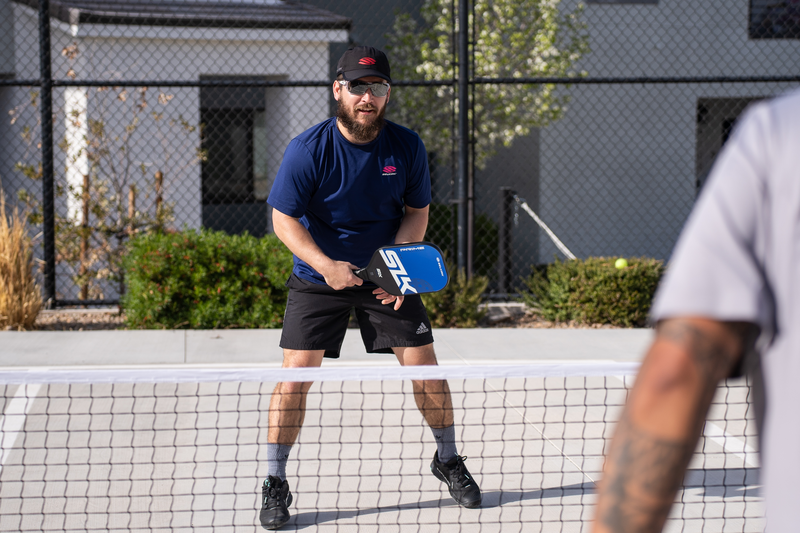The pickleball kitchen is an important part of the sport. Learning the pickleball kitchen rules will help you learn to be the best pickleball player you can be. Because the kitchen is also known as the “non-volley zone” (or NVZ) it’s important to also learn what a volley is in pickleball.
The terms “kitchen,” “non-volley zone,” and “NVZ” are often used interchangeably in pickleball.
What is a volley in pickleball?
During a pickleball rally, a volley is a ball that is hit in the air before the ball hits the court.
Here are a few more things to know about volleys:
- Volleys are often used just behind the kitchen line to hit a ball hard and low back to your opponent.
- Volleys may be hit by your forehand or backhand.
- Volleys are usually hit away from your opponent — and not directly at them.
What is the kitchen in pickleball?
The kitchen in pickleball is the area between the net and the “kitchen line.” It is also known as the NVZ or "non-volley zone."
Dimensions of the kitchen
The kitchen is a 7-foot x 20-foot zone on each side of the court. It spans the entire width of the pickleball court, and seven feet into each zone, starting from the net.
Dimensions of the kitchen line
The kitchen line is the line at the top of the kitchen, spanning 20 feet wide. All lines on the pickleball court are two inches wide, including the NVZ line.
When can you step into the kitchen?
You can step into the kitchen zone at any time during your game, except:
- When you are volleying the ball.
- When you have just volleyed the ball, and then your momentum takes you into the kitchen zone.
If you step into the kitchen, you must then re-establish both of your feet into the playing area behind the kitchen line before volleying the ball.
This means you can step into the zone when:
- The ball has bounced or is about to bounce in the kitchen.
- The ball has bounced or is about to bounce outside of the kitchen.
- Any other time during the game.
Re-establishing both feet
If you do step into the kitchen zone, please note that you must re-establish both of your feet outside of the kitchen zone before you can volley a ball.
The kitchen line
Is the kitchen line considered in or out? The kitchen line is a part of the kitchen, which means you should always consider the back of the kitchen to be the part of the kitchen line that is closest to the serving line.
The kitchen line during a serve
During a pickleball serve, the kitchen is considered out of bounds, or a fault — which means a ball that lands on the kitchen line is also considered a fault.
The kitchen line during a serve return
During a serve return, the ball may land anywhere on the playing surface, including within the kitchen and on the kitchen line.
The kitchen line during play
During play, the kitchen line is considered part of the kitchen — which means that if you are not allowed to be in the kitchen zone, stepping on the kitchen line is also a fault.
Contrary to the kitchen line, the sidelines and baseline on the court are considered in bounds when looking at line faults.
Pickleball momentum rule
When volleying the ball in pickleball, even if you are not in the kitchen zone, momentum can cause a fault. This includes anything you are wearing or touching, but does not include the air above the kitchen line.
- This includes anything you are wearing or touching, including:
- Your paddle.
- Your clothing or any other accessories.
- Your partner (if you are touching them).
- This is true even if the ball is declared dead before your momentum takes you into the zone.
- Your momentum includes any motion where you are not in control, including a run or jump. The official rules say “The act of volleying produces momentum that ends when the player regains balance and control of their motion or stops moving toward the non-volley zone.”
Why is it called the kitchen?
Although there is no definitive reason the non-volley zone in pickleball is called the kitchen, there are a few stories out there. One story is simply that pickleball borrowed the name “the kitchen” from another sport — shuffleboard. The kitchen is one of the zones on the shuffleboard table.
Other than that, no one seems to know where the term came from.
Everything you need to know about the kitchen in pickleball
The kitchen is one of the most important concepts in pickleball, and mastering when you can and can’t be in the zone will be crucial to your pickleball success. Remember these notes for your next game, and you will be on your way to success.

